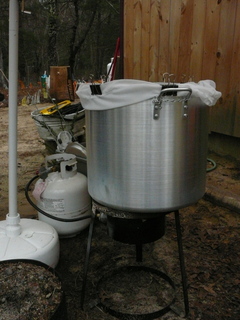Sparging Methods
Saturday, July 4th, 2009There are several ways to extract the sugars that we convert during the mash from the grain bed, they include, fly sparging, batch sparging and NO sparging.
Fly Sparging: When the mash is complete the brewer will vorlaugh and begin the sparge. With this method the brewer wants to slowly and gently add water to the top of the mash, leaving 1-2” of water above the grain bed at all times to avoid grain bed compaction, while also slowly draining the MLT into the boil kettle at the same rate. Typically a flow rate of .5 – .75 quarts per minute will result in an effective and efficient fly sparge. For this reason it can take 40-60 minutes to complete a sparge for a 5 gallon brew session.
Pros of fly sparging include:
- While one benefit of fly sparging in the past was increased lauter efficiency, this is debatable at best and with new split batch sparge techniques, most definitely not worth the extra time that it takes to perform. Thus the increased popularity in batch sparging.
Cons of fly sparging include:
- The need to have an effective mashout, due to the fact that fly sparging can take up to an hour, the brewer will want to denature any enzymes in the mash.
- Extended fly sparging can increase mash pH to a level where tannins will be extracted from the grain husks, which is not desirable
- Channeling can become a problem if the manifold in the bottom of the MLT is not designed properly, which causes the sparge water to drive right through the grain bed, reducing efficiency and leaving sugars in the MLT.
- You must match the Inflow of the sparge water very closely to the OUTflow of the wort from the bottom of the MLT during the entire sparge.
- Possible lower quality wort during extended fly sparging due to rising pH and low sugar content of final runnings.
Batch Sparging: This is a method by which the sparge water is typically split into two equal batches. Proper and accurate calculation of the sparge water requirement is essential! When the mash is complete the brewer will vorlaugh and drain the MLT into the boil kettle, followed by refilling the MLT with the first half of the sparge water. The brewer will then thoroughly stir the mash, let rest for a few minutes, varlough again and drain into the boil kettle a second time. The last of the two sparge water infusions will follow this same pattern.
Pros of batch sparging include:
- It can be completed more quickly than the slow and steady fly sparge.
- Channeling is reduced since the MLT is being drained completely between sparges.
- Temperature control is not as critical since each sparge water infusion is so large.
- It eliminates the need to monitor the runoff speed, no need to match this with the inflow as you do during a fly sparge.
Cons of batch sparging include:
- The grain must be resettled (vorlaughed) after each sparge water addition.
- MLT size may need to be larger to accommodate the sparge water and grain volume while mixing and resting between sparges.
- Efficiency “can” suffer, though with new split batch sparge techniques, brewers achieve 80+% efficiency, which is comparable to fly sparging techniques.
No Sparge, um, Sparging: This method is just as the name suggests… a method by which there is NO sparge. In order to accomplish this method, a brewer will mash in with ALL of the water that their brew will require., this could be upwards of 9-10 gallons of water alone for a 5 gallon brew session. When the mash is complete the brewer will vorlaugh and simply drain the entire MLT into the boil kettle, and if calculated correctly, meet their pre-boil volume.
Pros of ‘no sparge’ include:
- It can be completed more quickly than either fly sparging or batch sparging.
- Channeling is reduced since the MLT is being drained completely.
- It eliminates the need to monitor the runoff speed, no need to match this with the inflow as you do during a fly sparge.
- Extremely high quality wort due to no sparing resulting in low pH and high sugar content wort.
Cons of ‘no sparge’ include:
- MLT size may need to be larger to accommodate the entire quantity of water needed to complete a brew session and the grain bill.
- Efficiency will suffer, badly, due to the lack of an effective rinse of the grain bed.
- Nearly impossible to accurately estimate the OG of a beer with this method.
Closing Thoughts: From the discussion above, it is clear to see why batch sparging, namely the split batch sparge, has become so popular with home brewers who value their efficiency and their time. Don’t expect to hit 80% on the first try. Water chemistry and temperature control are big parts of success in this area, so make sure to check out the calculators at this site to prepare you.




















